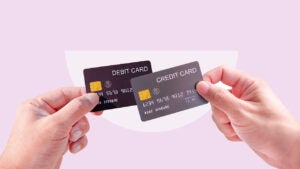Teaching kids about credit cards and debit cards

Our writers and editors used an in-house natural language generation platform to assist with portions of this article, allowing them to focus on adding information that is uniquely helpful. The article was reviewed, fact-checked and edited by our editorial staff prior to publication.
Key takeaways
- Teaching kids about credit cards and debit cards is an important part of their financial literacy.
- Credit cards borrow money from a card issuer, while debit cards withdraw money from a bank account.
- Understanding interest, credit limits, credit scores and fraud prevention can help with your child’s responsible card usage.
- Consider your child's age and spending needs to determine whether a debit or credit card is right for them.
While your kids may watch your spending habits, they may not understand how you pay at the grocery store, online or at an ATM. Debit cards and credit cards look similar but work in different ways. Interest, credit history, fraud prevention and card eligibility look different when comparing the two types of cards.
It’s important for kids to understand how to spend money wisely — and build a strong credit history over time. Here, we’ll explore how to teach kids about credit cards and debit cards.
How to teach your child the difference between credit and debit cards
When teaching your kid about credit cards and debit cards, it helps to start with some definitions. One of the biggest differences between credit cards and debit cards is where the money comes from. Here’s a quick breakdown:
- A credit card borrows funds from a line of credit that you repay at the end of the month.
- A debit card, on the other hand, withdraws funds immediately from your bank account when you make a purchase.
A credit card is basically a type of loan that you apply for with a credit card issuer. When using a credit card, you borrow money from the credit card issuer under the premise that you’ll pay it back. Credit cards also impact the cardholder’s credit, which can help your child build credit if used responsibly.
A debit card is issued by your bank and typically linked to a checking account. You can use it for most transactions in person and online. It’s also usually the easiest way to get cash from an ATM. While there’s typically no interest or fees charged for using your debit card (besides ATM fees), you may face a fee if you overdraw — or pay for something that costs more than what you have in your bank account.
Explaining interest to your kid
If you’re not able to repay the money you borrowed using a credit card on time, you’ll have to pay extra in interest until you can repay the full statement balance.
Credit card companies can charge interest that’s compounded daily. That means on the first day, the interest is added to the principal balance you owe each day. On the second day, you’re being charged for interest on the first day’s interest plus your original principal balance. And this keeps happening over and over to balloon up quickly.
You may also have to pay late fees if you don’t make at least the minimum payment by the due date. Some credit cards offer a 0 percent introductory APR period, where no interest is charged as long as you pay the balance by the end of the intro period.
On the other hand, debit cards don’t come with interest and usually don’t have fees if they‘re connected to a free checking account. You might have to pay to withdraw money from an ATM that’s outside your bank’s network or if you overdraw from your bank account.
Money tip: When using a credit card, try to only spend what you can afford to pay off each month so you won’t have to pay interest. Or, use a debit card to spend only the money you have.
Explaining credit limits to your kid
You can think of a credit limit as a bucket for your credit card spending. Just like a bucket can only hold so much water, your credit limit is the maximum amount you can borrow on your credit card. Your first credit card’s credit limit will be calculated based on factors like your credit score, type of card, income and debt-to-income ratio.
If you try to spend beyond your limit, you might face fees and declined transactions. You don’t want the bucket to overflow — so it’s important to keep track of your spending to not exceed your credit limit.
Money tip: Know the credit limit on your credit card so you don’t overspend. If you have a debit card, the limit is essentially the amount of money in your bank account.
Explaining credit scores to your kid
Learning about credit scores is important to kids’ financial literacy. A good credit score can help you get approved for loans, better interest rates and higher credit limits. In a nutshell, it tells potential lenders about your creditworthiness — or how likely you are to repay credit on time.
Here are some key ingredients to your credit score:
- Whether you make payments on time
- The types of credit you have
- How long you’ve had your credit accounts
- The amount of your available credit limit you use
- Any new credit applications
Using a debit card generally doesn’t affect your credit score.
Money tip: Using a credit card responsibly can help you build credit. But things like missing payments or using most of your available credit could have a negative impact on your credit score.
Explaining fraud prevention to your kid
Unfortunately, kids are at risk for fraud just like adults are. Credit card fraud is the most common type of fraud, according to the Federal Trade Commission (FTC). It can look like a scammer phishing for your personal account information, skimming on a card reader or using your lost or stolen card to make purchases.
When comparing the two types of cards, credit cards are typically safer because of their extra protections for cardholders. Credit card issuers often offer low or zero liability for unauthorized purchases and a longer window of time to report them.
Debit cards also protect against unauthorized purchases, but not to the same extent as credit cards. With a debit card, you typically have low or zero liability if you notify your bank within two business days of the unauthorized transaction. But notifying the bank after two days could lead to a higher liability.
Money tip: Learn how to protect yourself from fraud by doing things like keeping your account information and physical cards safe, as well as setting up mobile purchase alerts to spot any charges you didn’t make.
Should I give my child a credit or debit card?
Choosing the right first card with your child depends on their age and spending needs. Here are a few considerations for what type of card might be right for them.
When should I give my child a debit card?
Many banks offer teen checking accounts with debit cards for kids starting around 13 to 15 years old, or sometimes as young as six. The account is typically co-owned by a parent until the child turns 18.
A good time to give your child a debit card can be when they start making their own purchases (like at shopping malls or gas stations), earning their own money or simply asking questions about finance. Before they put the card in their wallet, make sure they understand how spending impacts their balance. You also might be able to use parental control features with the card that let you place spending limits and monitor transactions.
Keep in mind that debit card purchases don’t carry the same fraud protections as credit cards, and they won’t help your child build credit.
When should my teenager get a credit card?
Typically, your child has to be at least 18 years old to apply for their first credit card. But because of the 2009 Credit CARD Act, applicants under 21 also need a cosigner or proof of income.
Teens younger than 18 could gain access to credit sooner by becoming an authorized user on their parent’s credit card. The minimum age for an authorized user depends on the card issuer.
Some credit cards could help your child earn rewards to redeem for cash back, travel and more. However, there’s a risk of overspending. It’s easy to fall into the trap of thinking you’ll have money to pay for purchases later, only to get behind and fall into credit card debt. You could also discuss the option of a secured credit card or a prepaid card with your teen.
The bottom line
By understanding the difference between credit and debit cards, kids can make smart decisions when it comes to spending money. Concepts like interest, credit limits, credit scores and fraud prevention can help your child learn how to use their card responsibly.
Financial literacy starts at home, and having these conversations now can help set your child up for success further down the road.
Why we ask for feedback Your feedback helps us improve our content and services. It takes less than a minute to complete.
Your responses are anonymous and will only be used for improving our website.
You may also like









